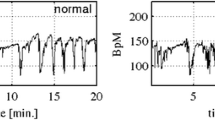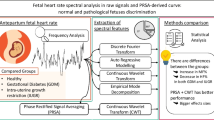Abstract
This paper presents an exploratory approach of the fetal heart rate (FHR) analysis, aiming to highlight potential limitations of the current predictive modeling attempts. To do so, a set of features that are usually encountered in FHR analysis as well as features extracted using a variant of symbolic aggregate approximation were projected onto a lower-dimensional space where patterns can easily be discerned. The results show, both in a qualitative and a quantitative manner, that there is high overlap between the classes that are formed using solely the umbilical cord pH information, irrespective of the selected dimensionality reduction method. These findings suggest that there is probably a limit to the performance expectation of the current pH-based systems and that alternative approaches should be also pursued to enhance the utility of computer-based decision support technologies.







Similar content being viewed by others
Notes
In two and three dimensions, the human eye is an excellent pattern recognition tool and easily perceives the complexity of a potential classification task and can also discern the existence of structures/patterns in the data. However, the use of three-dimensional (3D) scatter plots was not exploited, to avoid the extra complexity imposed by the selection of the best viewpoint.
References
Chen, H.Y., Chauhan, S.P., Ananth, C.V., Vintzileos, A.M., Abuhamad, A.Z.: Electronic fetal heart rate monitoring and its relationship to neonatal and infant mortality in the United States. Am. J. Obstet. Gynecol. 204, 491.e1–491.e10 (2011)
Blackwell, S.C., Grobman, W.A., Antoniewicz, L., Hutchinson, M., Bannerman, C.G.: Interobserver and intraobserver reliability of the NICHD 3-tier fetal heart rate interpretation system. Am. J. Obstet. Gynecol. 205(4), 378.e1–378.e5 (2011)
Alfirevic, Z., Devane, D., Gyte, G.M.: Continuous cardiotocography (CTG) as a form of electronic fetal monitoring (EFM) for fetal assessment during labour. Cochrane Database Syst. Rev. 3, CD006066 (2006)
FIGO: Guidelines for the use of fetal monitoring. Int. J. Gynaecol. Obstet. 25, 159–167 (1986)
Balayla, J., Shrem, G.: Use of artificial intelligence (AI) in the interpretation of intrapartum fetal heart rate (FHR) tracings: a systematic review and meta-analysis. Arch. Gynecol. Obstet. 300, 7–14 (2019)
Dash, S., Quirk, J.G., Djurić, P.M.: Fetal heart rate classification using generative models. IEEE Trans. Biomed. Eng. 61(11), 2796–2805 (2014)
Petrozziello, A., Jordanov, I., Papageorghiou, A., Redman, W.G., Georgieva, A.: Deep learning for continuous electronic fetal monitoring in labor. In: Conference on Proceedings IEEE Engineering in Medical and Biology Society, pp. 5866–5869 (2018)
Feng, G., Quirck, J, Djuric, P.: Supervised and unsupervised learning of fetal heart rate tracings with deep Gaussian processes. In: Presented at 14th Symposium on Neural Networks and Applications (NEUREL) (2018)
Czabanski, R., Jezewski, M., Wrobel, J., Jezewski, J., Horoba, K.: Predicting the risk of low-fetal birth weight from cardiotocographic signals using ANBLIR system with deterministic annealing and epsilon-insensitive learning. IEEE Trans. Inf Technol. Biomed. 14(4), 1062–1074 (2010)
Georgoulas, G., Stylios, C.D., Groumpos, P.P.: Predicting the risk of metabolic acidosis for newborns based on fetal heart rate signal classification using support vector machines. IEEE Trans. Biomed. Eng. 53(5), 875–884 (2006)
Spilka, J., Chudáček, V., Koucký, M., Lhotská, L., Huptych, M., Janků, P., Georgoulas, G., Stylios, C.: Using nonlinear features for fetal heart rate classification. Biomed. Signal Process. Control 7(4), 350–357 (2012)
Fanelli, A., Magenes, G., Campanile, M., Signorini, M.G.: Quantitative assessment of fetal well-being through CTG recordings: a new parameter based on phase-rectified signal average. IEEE J. Biomed. Health Inform. 17(5), 959–966 (2013)
Georgoulas, G., Karvelis, P., Spilka, J., Chudáček, V., Stylios, C.D., Lhotská, L.: Investigating pH based evaluation of fetal heart rate (FHR) recordings. Health Technol. 7, 1–14 (2017)
Spilka, J., Frecon, J., Leonarduzzi, R., Pustelnik, N., Abry, P., Doret, M.: Sparse support vector machine for intrapartum fetal heart rate classification. IEEE J. Biomed. Health Inform. 21(3), 664–671 (2017)
Georgieva, A., Payne, S.J., Moulden, M., Redman, C.W.: Artificial neural networks applied to fetal monitoring in labour. Neural Comput. Appl. 22(1), 85–93 (2013)
Czabański, R., Jeżewski, J., Horoba, K., Jeżewski, M.: Fetal state assessment using fuzzy analysis of fetal heart rate signals—agreement with the neonatal outcome. Biocybern. Biomed. Eng. 33(3), 145–155 (2013)
Ocak, H., Ertunc, H.M.: Prediction of fetal state from the cardiotocogram recordings using adaptive neuro-fuzzy inference systems. Neural Comput. Appl. 23(6), 1583–1589 (2013)
Dash, S., Quirk, J.G., Djuric, P.M.: Learning dependencies among fetal heart rate features using Bayesian networks. In: Engineering in Medicine and Biology Society (EMBC), pp. 6204–6207 (2012)
Norén, H., Amer-Wåhlin, I., Hagberg, H., Herbst, A., Kjellmer, I.: Fetal electrocardiography in labor and neonatal outcome: data from the Swedish randomized controlled trial on intrapartum fetal monitoring. Am. J. Obstet. Gynecol. 188(1), 183–192 (2003)
Spilka, J.: Complex approach to fetal heart rate analysis: a hierarchical classification model. Ph.D. Thesis, Czech Technical University in Prague Department of Cybernetics (2013)
Costa Santos, C., Bernardes, J., Vitányi P.M., Antunes, L.: Clustering fetal heart rate tracings by compression. In: Computer-Based Medical Systems, CBMS, pp. 685–690 (2006)
Ferrario, M., Signorini, M.G., Magenes, G.: Complexity analysis of the fetal heart rate variability: early identification of severe intrauterine growth-restricted fetuses. Med. Biol. Eng. Comput. 47(9), 911–919 (2009)
Chudacek, V., Spilka, J., Bursa, M., Janku, P., Hruban, L., Huptych, M., Lhotska, L.: Open access intrapartum CTG database. BMC Pregnancy Childbirth 14, 16 (2014)
Lin, J., Keogh, E., Lonardi S., Chiu, B.: A symbolic representation of time series, with implications for streaming algorithms. In: 8th ACM SIGMOD Workshop on Research Issues in Data Mining and Knowledge Discovery, pp. 2–11 (2003)
Theodoridis, S., Koutroumbas, K.: Pattern Recognition, 4th edn. Academic Press, San Diego (2009)
Wasikowski, M., Chen, X.: Combating the small sample class imbalance problem using feature selection. IEEE Trans. Knowl. Data Eng. 22(10), 1388–1400 (2010)
Lin, J., Keogh, E., Wei, L., Lonardi, S.: Experiencing SAX: a novel symbolic representation of time series. Data Min. Knowl. Discov. 15(2), 107–144 (2007)
Yousofvand, L., Abdolhossein, F., Fardin, A.: Person identification using ECG signal’s symbolic representation and dynamic time warping adaptation. Signal Image Video Process. 13(2), 245–251 (2019)
Keogh, E., Lin J., Fu., A.: Hot sax: efficiently finding the most unusual time series subsequence. In: 5th IEEE International Conference on Data Mining, pp. 226–233 (2005)
Keogh, E., Chakrabarti, K., Pazzani, M., Mehrotra, S.: Dimensionality reduction for fast similarity search in large time series databases. J. Knowl. Inf. Syst. 3(3), 263–286 (2000)
Yi, K., Faloutsos, C.: Fast time sequence indexing for arbitrary Lp norms. In: 26th International Conference on Very Large Databases, Cairo, Egypt, (2000)
Cox, T.F., Cox, M.A.: Multidimensional Scaling. CRC Press, Boca Raton (2010)
van der Maaten, L.J., Postma, E.O., van den Herik, H.J.: Dimensionality reduction: a comparative review. J. Mach. Learn. Res. 10, 66–71 (2009)
Machado, J.A., Tenreiro, E., Dumitru, B.: Analysis of UV spectral bands using multidimensional scaling. Signal Image Video Process. 9(3), 573–580 (2015)
Lerner, B., Guterman, H., Aladjem, M., Dinsteint, I., Romem, Y.: On pattern classification with Sammon’s nonlinear mapping an experimental study. Pattern Recognit. 31(4), 371–381 (1998)
Preben, F., Moeslund, T.: Invariant gait continuum based on the duty-factor. Signal Image Video Process. 3(4), 391 (2009)
Sammon, J.: A nonlinear mapping for data structure analysis. IEEE Trans. Comput. 18(5), 401–409 (1969)
Tenenbaum, J., De Silva, V., Langford, J.: A global geometric framework for nonlinear dimensionality reduction. Science 290(5500), 2319–2323 (2000)
Demartines, P., Hérault, J.: Curvilinear component analysis: a self-organizing neural network for nonlinear mapping of data sets. IEEE Trans. Neural Netw. 8(1), 148–154 (1997)
Chawla, N.V., Bowyer, K.W., Hall, L.O., Kegelmeyer, W.P.: SMOTE: synthetic minority over-sampling technique. J. Artif. Intell. Res. 16, 321–357 (2002)
Suykens, J., Vandewalle, J.: Least squares support vector machine classifiers. Neural Process. Lett. 9, 293–300 (1999)
Spilka, J., Chudáček, V., Janků, P., Hruban, L., Burša, M., Huptych, M., Zach, L., Lhotská, L.: Analysis of obstetricians’ decision making on CTG recordings. J. Biomed. Inform. 51, 72–79 (2014)
Author information
Authors and Affiliations
Corresponding author
Additional information
Publisher's Note
Springer Nature remains neutral with regard to jurisdictional claims in published maps and institutional affiliations.
Rights and permissions
About this article
Cite this article
Georgoulas, G., Karvelis, P., Chudacek, V. et al. An exploratory approach to fetal heart rate–pH-based systems. SIViP 15, 43–51 (2021). https://doi.org/10.1007/s11760-020-01727-y
Received:
Revised:
Accepted:
Published:
Issue Date:
DOI: https://doi.org/10.1007/s11760-020-01727-y




